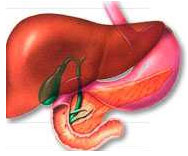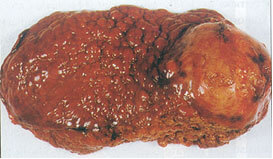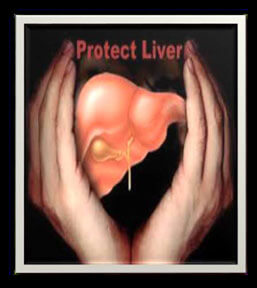Know About Your Liver
The liver is the largest internal organ in the human body. The liver sits just under your rib cage on the right side of your abdomen, below the diaphragm and on top of the stomach, right kidney, and intestines. The liver is a dark reddish-brown, cone shaped organ. In males it weighs from 1.4 to 1.6 kilograms, in females from 1.2 to 1.4 kilograms.
The gallbladder, which stores bile made in the liver, is found tucked under your liver. Liver is made up of two separate sections, or lobes: the larger right lobe and the smaller left lobe.
Liver is vital for your good health and long life. You will be surprised to know that it performs over 500 functions. Liver’s biggest role is to filter blood all day. Liver filters more than a liter of blood every minute which is about 22 gallons of blood per hour. Liver gets all blood supply from the hepatic artery and the hepatic portal vein. The hepatic artery brings oxygen-rich blood to liver and hepatic portal vein brings blood from digestive system carrying nutrients, medications, or toxins.
Functions of the liver
Liver is vital for your good health and long life. You will be surprised to know that it performs over 500 functions. Liver’s biggest role is to filter blood all day. Liver filters more than a liter of blood every minute which is about 22 gallons of blood per hour. Liver gets all blood supply from the hepatic artery and the hepatic portal vein. The hepatic artery brings oxygen-rich blood to liver and hepatic portal vein brings blood from digestive system carrying nutrients, medications, or toxins.
Metabolic
- liver metabolizes most hormones and ingested drugs to either more or less active products.
- Production of certain proteins for blood plasma.
- Production of cholesterol and special proteins to help carry fats through the body.
Storage
- Glycogen
- Vitamins A, D, E, K (fat Soluble)
- B12 (water soluble)
- Iron
Excretory/Secretory
- Purification, Transformation, and Clearance: - The liver removes harmful substances (such as ammonia and toxins) from the blood and then breaks them down or transforms them into less harmful compounds.
Circulatory
- Filters Blood:– All the blood leaving the stomach and intestines passes through the liver, which removes toxins, byproducts, and other harmful substances.
Coagulation
Production and secretion of coagulation factors:–
- Fibrinogen I
- Prothrombin II
- Factors (V, VII, IX, X, XI)
- Protein C
- Protein S
- Antithrombin III
Liver regeneration
The liver is the only human organ that has the remarkable property of self-regeneration.
If a part of the liver is removed, the remaining parts can grow back to its original size
and shape.
Liver in Digestion
In the human digestive system, the process of digestion has many stages, the first of
which starts in the mouth (oral cavity). Digestion involves the breakdown of food into
smaller and smaller components which can be absorbed and assimilated into the body
The liver is the largest solid organ inside the body and plays a very important role in the
process of digestion by physically regulating it and ensuring release of post digestive
nutrients into the system.
The liver and bile
Bile is a bitter-to-taste fluid that is produced in the liver. It plays an important role in the digestion and absorption of lipids and also fat-soluble vitamins A, D, E, and K. Bile also serves as a carrier for cholesterol to be excreted. Bile is alkaline in nature and it neutralizes excessive stomach acids before the food enters the ileum. Bile is antibacterial in nature and kills bacteria that may be present in food.
SALIENT FACTS ABOUT LIVER
- Dark/Reddish Brown, vital organ.
- Largest internal organ and largest gland.
- Performs both metabolic and excretory functions
- It has double blood supply
- Lies on the right side of the abdominal cavity beneath the diaphragm.
- In males it weighs from 1.4 to 1.6 kgs, in females from 1.2 to 1.4 kgs
- The Liver is extremely resilient.
Healthy Liver

Diseased Liver

Diseases of Liver
Liver disease can be inherited (genetic) or caused by a variety of factors that damage the liver, such as viruses, excessive alcohol use, obesity, Autoimmune disease and reactions to medications, street drugs, or toxic chemicals.
Over a period of time, conditions that damage the liver can lead to scarring (cirrhosis), which can further lead to liver failure, a life-threatening condition. Early treatment may give the liver time to heal.
Causes of Liver Diseases
- Viruses
- Genetics
- Autoimmune disease
- Excessive use of alcohol
- Poor diet and/or obesity
- Reactions to medications, street drugs, or toxic chemicals
Disorders of Liver
- Viral Hepatitis
- Alcoholic liver disease
- Fatty liver
- Cirrhosis
- Liver cancer
- Acute liver failure
- Gallstones
- Hemochromatosis
- Wilson's disease
Sign and Symptoms of Liver Dysfunction
Liver disease may cause noticeable signs and symptoms which may include:
- Skin and eyes that appear yellowish (jaundice)
- Abdominal pain and swelling
- Swelling in the legs and ankles
- Itchy skin
- Dark urine color
- Pale stool color
- Chronic fatigue
- Nausea or vomiting
- Loss of appetite
- Tendency to bruise easily
Infection
The viruses that cause liver damage can be spread through feco-oral route (contaminated food or water) or the parenteral route (via blood, blood products or semen). Hepatitis A and E are spread through feco-oral route, whereas Hepatitis B and Hepatitis C are spread through parenteral route.
Sign and Symptoms of Liver Dysfunction
Diseases in which your immune system attacks certain parts of your body (autoimmune) can affect your liver. Examples of autoimmune liver diseases include:
- Autoimmune hepatitis
- Primary biliary cholangitis
- Primary sclerosing cholangitis
Genetics
An abnormal gene inherited from one or both of your parents can cause various substances to build up in your liver, resulting in liver damage. Genetic liver diseases include:
- Hemochromatosis
- Wilson's disease
- Alpha-1 antitrypsin deficiency
Cancer and other growths
Examples include:
- Liver cancer
- Bile duct cancer
- Liver adenoma
Other
Additional, common causes of liver disease include:
- Chronic alcohol abuse
- Fat accumulation in the liver (nonalcoholic fatty liver disease)
- Certain prescription or over-the-counter medications
- Certain herbal compounds
Diagnosis of Liver Diseases
There are a number of tests that can determine how well the liver is functioning. Your doctor will assess your symptoms and determine the best approach. Your doctor may request:
Blood Tests to diagnose liver disease:
- LFT (Liver function): A liver function panel checks how well the liver is working and consists of many different blood tests.
- ALT (Alanine Aminotransferase): An elevated ALT helps identify liver disease or damage from any number of causes, including hepatitis.
- AST (Aspartate Aminotransferase): Along with an elevated ALT, the AST checks for liver damage.
- Alkaline phosphatase: Alkaline phosphatase is present in bile-secreting cells in the liver; it's also in bones. High levels often mean bile flow out of the liver is blocked.
- Bilirubin: High bilirubin levels suggest a problem with the liver, and correlated with clinical jaundice.
- Albumin: As part of total protein levels, albumin helps determine how well the liver is working. Low albumin levels often reflect poor nutrition.
- Ammonia: Ammonia levels in the blood rise when the liver is not functioning properly.
- Hepatitis A tests: If hepatitis A is suspected, the doctor will test liver function as well as antibodies to detect the hepatitis A virus.
- Hepatitis B tests: Your doctor can test for hepatitis B antigen (HBsAg) to determine if you have been infected with the hepatitis B virus.
- Hepatitis C tests: Blood tests (anti-HCV) can determine if you have been infected with the hepatitis C virus.
- Prothrombin Time (PT): A prothrombin time, or PT, is commonly done to see if someone is taking the correct dose of the blood thinner warfarin (Coumadin). It also checks for blood clotting problems.
- Partial Thromboplastin Time (PTT): A PTT is done to check for blood clotting problems.
Imaging Tests:
- Ultrasound: An abdominal ultrasound can test for many liver conditions, including cancer, cirrhosis, or problems from gallstones.
- CT scan (computed tomography): A CT scan of the abdomen gives detailed pictures of the liver and other abdominal organs.
- MRI: MRI of Liver is highly efficient in diagnosing various liver disorders.
- Fibroscan: It is useful in diagnosis of Fatty Liver and liver stiffness (or fibrosis).
- Liver biopsy: A liver biopsy is the gold standard for diagnosis of various liver diseases, but being invasive in nature, it is done only in selected cases after other tests, such as a blood test or liver imagiung, indicates a possible liver problem.
Some treatment modalities for Liver Diseases
- Hepatitis A and Hepatitis E treatment: They usually goes resolve with time on supportive measures. However, treatment should be monitored under
- The supervision of a liver specialist, as rarely patients can develop acute liver failure which is a life-threatening condition.
- Hepatitis B treatment: Chronic hepatitis B often requires treatment with antiviral medication.
- Hepatitis C treatment: Highly efficient antiviral drugs are now available to treat and cure hepatitis C.
- Paracentesis: When severe ascites -- swelling in the belly from liver failure -- causes discomfort, a needle can be inserted through the skin to drain fluid from the abdomen.
- ERCP (Endocscopic retrograde cholangiopancreatography): Using a long, flexible tube with a camera and tools on the end, doctors can diagnose and even treat some liver problems.
- Liver transplant: A liver transplant is needed when the liver no longer functions adequately, whatever the cause.
- Liver cancer treatment: While liver cancer is usually difficult to cure, treatment consists of chemotherapy and radiation. In some cases, surgical resection or liver transplantation is performed.
Maintaining a Healthy Liver
LIVER is one of your most important organs; you cannot live without it. The liver is like a processing plant for the body. Raw materials such as nutrients, alcohol, herbs and drugs are absorbed from the gut and transported to the liver where they are processed, detoxified, stored and transported to the rest of the body.
Risk factors:
Factors that may increase your risk of liver disease include:
- Heavy alcohol use
- Obesity
- Type 2 diabetes
- Tattoos or body piercings
- Injecting drugs using shared needles
- Transfusion of blood and blood products
- Exposure to other people's blood and body fluids
- Unprotected sex
- Exposure to certain chemicals or toxins
- Family history of liver disease
Complications
Complications of liver disease vary, depending on the cause of your liver problems. Untreated liver disease may progress to liver failure, a life-threatening condition.
Prevention
Liver disease can be avoided by taking active steps toward a healthy life. The following are some recommendations
- Avoid Illicit Drugs: Illicit drugs are toxins that the liver filters out. Taking these drugs can cause long-term damage.
- Avoid Alcohol: Avoiding alcohol is the best policy, especially if you have other liver problems such as hepatitis B, hepatitis C, fatty liver, etc. The effort should be to stop or cut down your alcohol intake among those who already drink. For those who do not drink, it is best not to develop the habit of alcohol consumption.
- Avoid risky behavior. If you choose to have tattoos or body piercings, think about cleanliness and safety when selecting a shop.
- Exercise Regularly: A regular exercise routine will help promote general health for every organ, including the liver.
- Eat Healthy Foods: Eating excessive fats can make it difficult for the liver to function and lead to fatty liver disease. Wash your hands thoroughly before eating or preparing foods.
- Practice Safe Sex: Use protection to avoid sexually transmitted diseases.
- Vaccinate: Universal vaccination against Hepatitis B is advised.
- Use medications wisely. Take prescription and nonprescription drugs only when needed and only in recommended doses. Don't mix medications and alcohol.
- Avoid contact with other people's blood and body fluids. Hepatitis viruses can be spread by accidental needle sticks or improper cleanup of blood or body fluids.
- Maintain a healthy weight. Obesity can cause nonalcoholic fatty liver disease.










